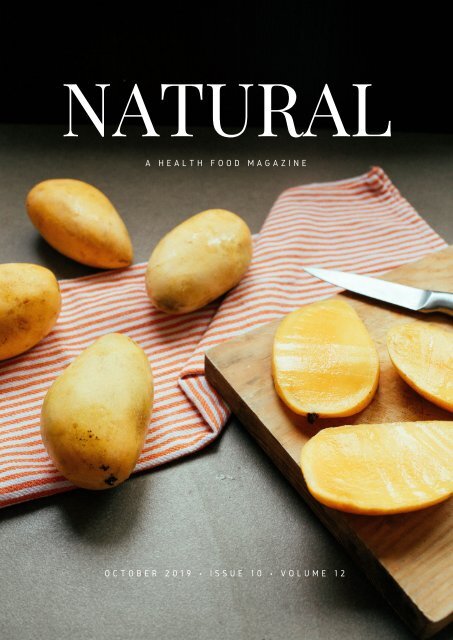dwdproject-design
You also want an ePaper? Increase the reach of your titles
YUMPU automatically turns print PDFs into web optimized ePapers that Google loves.
NATURAL<br />
A H E A L T H F O O D M A G A Z I N E<br />
O C T O B E R 2 0 1 9 • I S S U E 1 0 • V O L U M E 1 2
H E A L T H M A G A Z I N E<br />
CONTENTS<br />
05<br />
F R O M T H E E D I T O R<br />
A brief note from Health Mag's editor about<br />
how we should make a health revolution<br />
for the better.<br />
13<br />
G R E E N S M O O T H I E C R A Z E<br />
We jump on the bandwagon and introduce you<br />
to our three original recipes<br />
17<br />
F O O D O R H O R M O N E S ?<br />
Why and how our food affects our health and<br />
its impact on our hormones.<br />
23<br />
W H Y F R U I T I S T H E B E S T<br />
M E D I C I N E W E C A N H A V E<br />
We talk to a vegan doctor Neil Barnard, who<br />
claims that a plant-based diet can cure<br />
diabetes, heart disease, and even cancer.
BETTER<br />
BREAKFASTS<br />
L E A R N H O W T O S T A R T Y O U R D A Y<br />
R I G H T . W E G I V E Y O U T I P S B E L O W !<br />
A magazine is a publication, usually a periodical publication, which is<br />
printed or electronically published (sometimes referred to as an online<br />
magazine). Magazines are generally published on a regular schedule<br />
and contain a variety of content. They are generally financed by<br />
advertising, by a purchase price, by prepaid subscriptions, or a<br />
combination of the three.<br />
At its root, the word "magazine" refers to a collection or storage<br />
location. In the case of written publication, it is a collection of written<br />
articles. This explains why magazine publications share the word root<br />
with gunpowder magazines, artillery magazines, firearms magazines,<br />
and, in French, retail stores such as department stores. By definition,<br />
a magazine paginates with each issue starting at page three, with the<br />
standard sizing being 8 3/8 × 10 7/8 inches. However, in the technical<br />
sense a journal has continuous pagination throughout a volume. Thus<br />
Business Week, which starts each issue anew with page one,<br />
is a magazine, but the Journal of Business<br />
Communication, which starts each volume<br />
with the winter issue and continues the<br />
same sequence of pagination throughout<br />
the coterminous year, is a journal. Some<br />
professional or trade publications are also<br />
peer-reviewed, an example being the<br />
Journal of Accountancy. Academic or<br />
professional publications that are not<br />
peer-reviewed are generally professional<br />
magazines. That a publication calls itself a<br />
journal does not make it a journal in the<br />
technical sense; The Wall Street Journal is<br />
actually a newspaper. A magazine is a<br />
publication, usually a periodical publication,<br />
which is printed or electronically published<br />
(sometimes referred to as an online<br />
magazine). Magazines are generally<br />
published on a regular schedule and<br />
contain a variety of content. They are<br />
generally financed by advertising<br />
by a purchase price, by prepaid<br />
subscriptions, or a combination of the<br />
three. At its root, the word "magazine"<br />
refers to a collection or storage location.<br />
In the case of written publication, it is a<br />
collection of written articles. This explains<br />
why magazine publications share the word<br />
root with gunpowder magazines, artillery<br />
magazines, firearms magazines, and, in<br />
French, retail stores such as department<br />
stores. By definition, a magazine<br />
paginates with each issue starting at page<br />
three, with the standard sizing being 8<br />
3/8 × 10 7/8 inches. However, in the<br />
technical sense a journal has continuous<br />
pagination throughout a volume. Thus<br />
Business Week, which starts each issue<br />
anew with page one is a magazine, but the<br />
Journal of Business Communication, which<br />
starts each volume with the winter issue<br />
and continues the same sequence.
TURN HEALTH<br />
APPETIZING<br />
V E G E T A B L E S S O U N D B O R I N G , S O W E<br />
G I V E Y O U T I P S B E L O W T O M A K E I T<br />
A L L B E T T E R<br />
A magazine is a publication, usually<br />
a periodical publication, which is<br />
printed or electronically published<br />
(sometimes referred to as an<br />
online magazine). Magazines are<br />
generally published on a regular<br />
schedule and contain a variety of<br />
content. They are generally<br />
financed by advertising, by a<br />
purchase price, by prepaid<br />
subscriptions, or a combination of<br />
the three.<br />
At its root, the word "magazine"<br />
refers to a collection or storage<br />
location. In the case of written<br />
publication, it is a collection of<br />
written articles. This explains why<br />
magazine publications share the<br />
word root with gunpowder<br />
magazines, artillery magazines,<br />
firearms magazines, and, in French,<br />
retail stores such as department<br />
stores. By definition, a magazine<br />
paginates with each issue starting<br />
at page three, with the standard<br />
sizing being 8 3/8 × 10 7/8 inches.<br />
However, in the technical sense a<br />
journal has continuous pagination<br />
throughout a volume. Thus<br />
Business Week, which starts each<br />
issue anew with page one, is a<br />
magazine, but the Journal of<br />
Business Communication, which<br />
starts each volume with the winter<br />
issue and continues the same<br />
sequence of pagination throughout<br />
the coterminous year, is a journal.<br />
Some professional or trade<br />
publications are also peerreviewed,<br />
an example being the<br />
Journal of Accountancy. Academic<br />
or professional publications that<br />
are not peer-reviewed are<br />
generally professional magazines.<br />
That a publication calls itself a<br />
journal does not make it a journal<br />
in the technical sense; The Wall<br />
Street Journal is actually a<br />
newspaper. A magazine is a<br />
publication, usually a periodical<br />
publication, which is printed or<br />
electronically published (sometimes<br />
referred to as an online magazine).<br />
Magazines are generally published<br />
on a regular schedule and contain a<br />
variety of content. They are<br />
generally financed by<br />
advertising by a purchase price, by<br />
prepaid subscriptions, or a<br />
combination of the three. At its<br />
root, the word "magazine" refers<br />
to a collection or storage location.<br />
In the case of written publication,<br />
it is a collection of written articles.<br />
This explains why magazine<br />
publications share the word root<br />
with gunpowder magazines,<br />
artillery magazines, firearms<br />
magazines, and, in French, retail<br />
stores such as department stores.<br />
By definition, a magazine paginates<br />
with each issue starting at page<br />
three, with the standard sizing<br />
being 8 3/8 × 10 7/8 inches.<br />
However, in the technical sense a<br />
journal has continuous pagination<br />
throughout a volume.
EAT REAL<br />
GOOD FOOD<br />
H E A L T H I S W E A L T H , A N D W E S H O U L D<br />
S T A R T I N V E S T I N G I N W H A T W E P L A C E<br />
I N S I D E O U R P A N T R Y .<br />
A magazine is a publication, usually a periodical<br />
publication, which is printed or electronically<br />
published (sometimes referred to as an online<br />
magazine). Magazines are generally published on a<br />
regular schedule and contain a variety of content.<br />
They are generally financed by advertising, by a<br />
purchase price, by prepaid subscriptions, or a<br />
combination of the three.<br />
At its root, the word "magazine" refers to a<br />
collection or storage location. In the case of<br />
written publication, it is a collection of written<br />
articles. This explains why magazine publications<br />
share the word root with gunpowder magazines,<br />
artillery magazines, firearms magazines, and, in<br />
French, retail stores such as department stores. By<br />
definition, a magazine paginates with each issue<br />
starting at page three, with the standard sizing<br />
being 8 3/8 × 10 7/8 inches. However, in the<br />
technical sense a journal has continuous pagination<br />
throughout a volume. Thus Business Week, which<br />
starts each issue anew with page one, is a<br />
magazine, but the Journal of Business<br />
Communication, which starts each volume with the<br />
winter issue and continues the same sequence of<br />
pagination throughout the coterminous year, is a<br />
journal. Some professional or trade publications are<br />
also peer-reviewed, an example being the Journal<br />
of Accountancy. Academic or professional<br />
publications that are not peer-reviewed are<br />
generally professional magazines. That a<br />
publication calls itself a journal does not make it a<br />
journal in the technical sense; The Wall Street<br />
Journal is actually a newspaper. A magazine is a<br />
publication, usually a periodical publication, which is<br />
printed or electronically published (sometimes<br />
referred to as an online magazine). Magazines are<br />
generally published on a regular schedule and<br />
contain a variety of content. They are generally<br />
financed by advertising by a purchase price, by<br />
prepaid subscriptions, or a combination of the<br />
three. At its root, the word "magazine" refers to a<br />
collection or storage location. In the case of<br />
written publication, it is a collection of written<br />
articles. This explains why magazine publications<br />
share the word root with gunpowder magazines,<br />
artillery magazines, firearms magazines, and, in<br />
French, retail stores such as department stores. By<br />
definition, a magazine paginates with each issue<br />
starting at page three, with the standard sizing<br />
being 8 3/8 × 10 7/8 inches. However, in the<br />
technical sense a journal has continuous pagination.



